Case Study: Operant Conditioning Strategies for Classroom Behavior
VerifiedAdded on 2023/06/10
|9
|3995
|291
Case Study
AI Summary
This case study examines the application of operant conditioning principles in addressing disruptive classroom behavior exhibited by primary 5 students. The study highlights the challenges faced by a teacher named Jane, whose students demonstrate a lack of participation, inadequate responsiveness, and delays in completing assignments. Drawing upon Skinner's operant conditioning theory, the analysis explores how positive and negative reinforcement techniques can be employed to encourage positive behaviors and reduce undesirable ones. The discussion incorporates Erikson's psychosocial theory of development and Piaget's stage of Cognitive Development, Bandura’s social learning theory and Kohlberg’s theory of Moral Development to provide a comprehensive understanding of the students' developmental needs and cognitive abilities. The study also addresses the strengths and weaknesses of operant conditioning, emphasizing the importance of occasional rewards and collaboration with other relevant theories to enhance its suitability in managing classroom behavior. The case study concludes by suggesting strategies for Jane to effectively implement operant conditioning techniques to foster a more positive and productive learning environment.
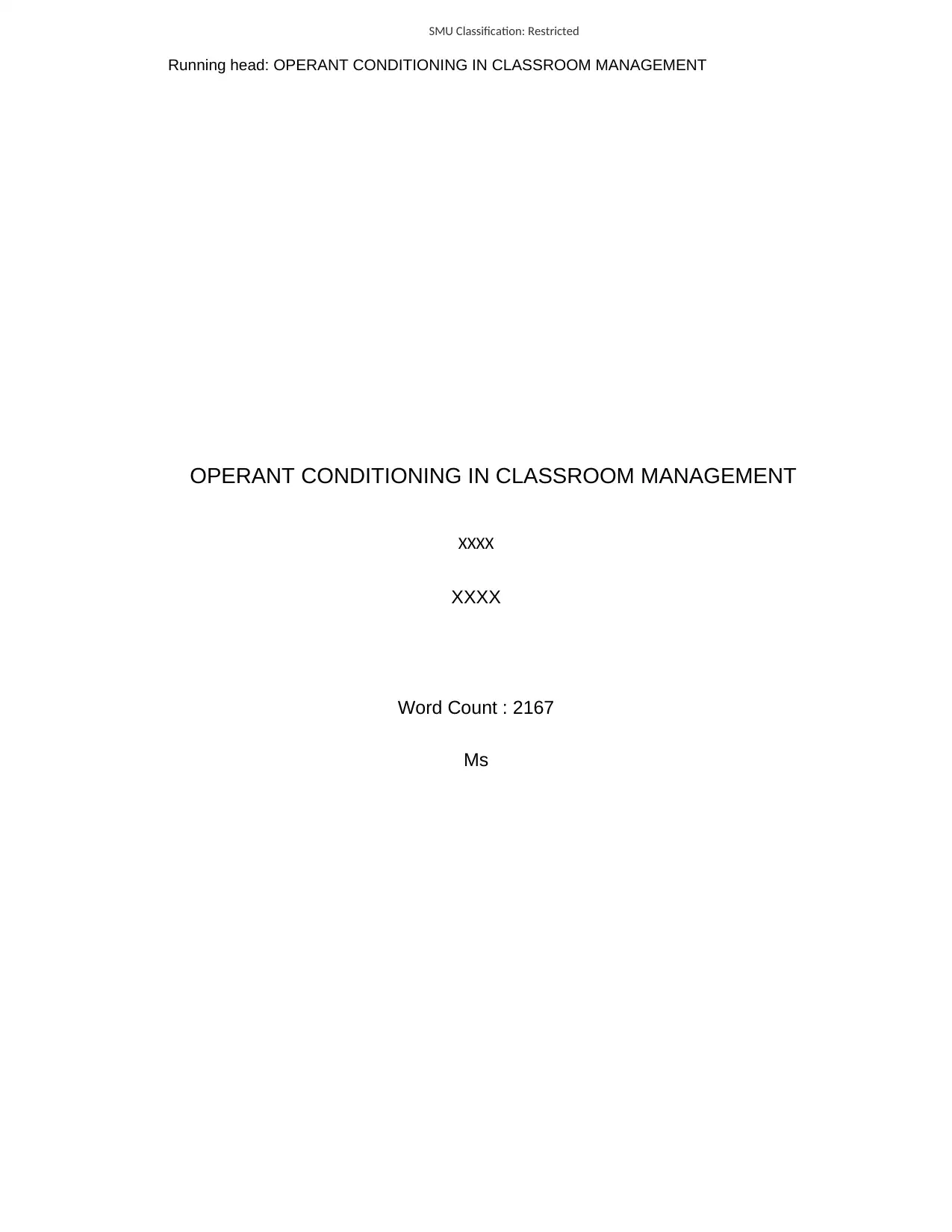
SMU Classification: Restricted
Running head: OPERANT CONDITIONING IN CLASSROOM MANAGEMENT
OPERANT CONDITIONING IN CLASSROOM MANAGEMENT
XXXX
XXXX
Word Count : 2167
Ms
Running head: OPERANT CONDITIONING IN CLASSROOM MANAGEMENT
OPERANT CONDITIONING IN CLASSROOM MANAGEMENT
XXXX
XXXX
Word Count : 2167
Ms
Paraphrase This Document
Need a fresh take? Get an instant paraphrase of this document with our AI Paraphraser
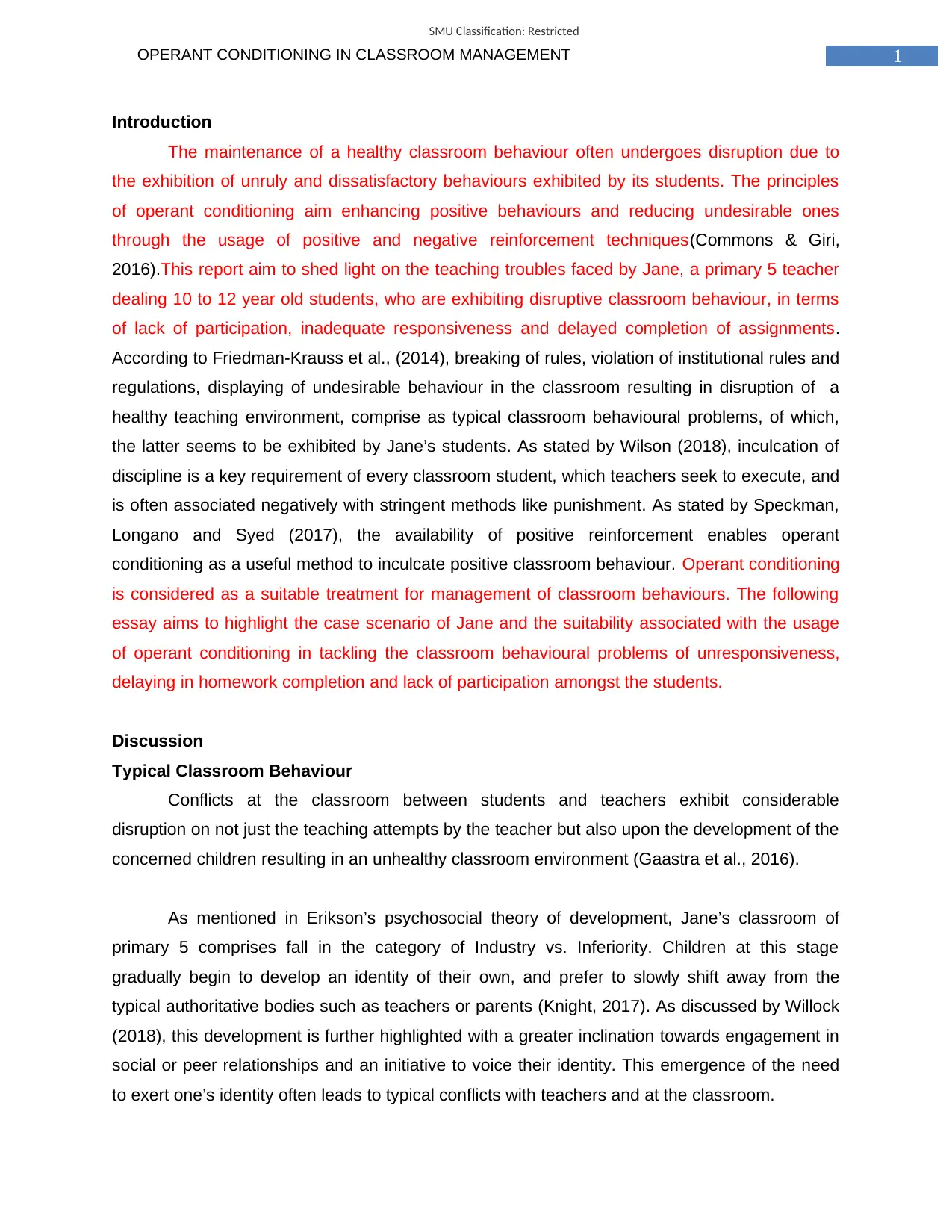
1OPERANT CONDITIONING IN CLASSROOM MANAGEMENT
SMU Classification: Restricted
Introduction
The maintenance of a healthy classroom behaviour often undergoes disruption due to
the exhibition of unruly and dissatisfactory behaviours exhibited by its students. The principles
of operant conditioning aim enhancing positive behaviours and reducing undesirable ones
through the usage of positive and negative reinforcement techniques(Commons & Giri,
2016).This report aim to shed light on the teaching troubles faced by Jane, a primary 5 teacher
dealing 10 to 12 year old students, who are exhibiting disruptive classroom behaviour, in terms
of lack of participation, inadequate responsiveness and delayed completion of assignments.
According to Friedman-Krauss et al., (2014), breaking of rules, violation of institutional rules and
regulations, displaying of undesirable behaviour in the classroom resulting in disruption of a
healthy teaching environment, comprise as typical classroom behavioural problems, of which,
the latter seems to be exhibited by Jane’s students. As stated by Wilson (2018), inculcation of
discipline is a key requirement of every classroom student, which teachers seek to execute, and
is often associated negatively with stringent methods like punishment. As stated by Speckman,
Longano and Syed (2017), the availability of positive reinforcement enables operant
conditioning as a useful method to inculcate positive classroom behaviour. Operant conditioning
is considered as a suitable treatment for management of classroom behaviours. The following
essay aims to highlight the case scenario of Jane and the suitability associated with the usage
of operant conditioning in tackling the classroom behavioural problems of unresponsiveness,
delaying in homework completion and lack of participation amongst the students.
Discussion
Typical Classroom Behaviour
Conflicts at the classroom between students and teachers exhibit considerable
disruption on not just the teaching attempts by the teacher but also upon the development of the
concerned children resulting in an unhealthy classroom environment (Gaastra et al., 2016).
As mentioned in Erikson’s psychosocial theory of development, Jane’s classroom of
primary 5 comprises fall in the category of Industry vs. Inferiority. Children at this stage
gradually begin to develop an identity of their own, and prefer to slowly shift away from the
typical authoritative bodies such as teachers or parents (Knight, 2017). As discussed by Willock
(2018), this development is further highlighted with a greater inclination towards engagement in
social or peer relationships and an initiative to voice their identity. This emergence of the need
to exert one’s identity often leads to typical conflicts with teachers and at the classroom.
SMU Classification: Restricted
Introduction
The maintenance of a healthy classroom behaviour often undergoes disruption due to
the exhibition of unruly and dissatisfactory behaviours exhibited by its students. The principles
of operant conditioning aim enhancing positive behaviours and reducing undesirable ones
through the usage of positive and negative reinforcement techniques(Commons & Giri,
2016).This report aim to shed light on the teaching troubles faced by Jane, a primary 5 teacher
dealing 10 to 12 year old students, who are exhibiting disruptive classroom behaviour, in terms
of lack of participation, inadequate responsiveness and delayed completion of assignments.
According to Friedman-Krauss et al., (2014), breaking of rules, violation of institutional rules and
regulations, displaying of undesirable behaviour in the classroom resulting in disruption of a
healthy teaching environment, comprise as typical classroom behavioural problems, of which,
the latter seems to be exhibited by Jane’s students. As stated by Wilson (2018), inculcation of
discipline is a key requirement of every classroom student, which teachers seek to execute, and
is often associated negatively with stringent methods like punishment. As stated by Speckman,
Longano and Syed (2017), the availability of positive reinforcement enables operant
conditioning as a useful method to inculcate positive classroom behaviour. Operant conditioning
is considered as a suitable treatment for management of classroom behaviours. The following
essay aims to highlight the case scenario of Jane and the suitability associated with the usage
of operant conditioning in tackling the classroom behavioural problems of unresponsiveness,
delaying in homework completion and lack of participation amongst the students.
Discussion
Typical Classroom Behaviour
Conflicts at the classroom between students and teachers exhibit considerable
disruption on not just the teaching attempts by the teacher but also upon the development of the
concerned children resulting in an unhealthy classroom environment (Gaastra et al., 2016).
As mentioned in Erikson’s psychosocial theory of development, Jane’s classroom of
primary 5 comprises fall in the category of Industry vs. Inferiority. Children at this stage
gradually begin to develop an identity of their own, and prefer to slowly shift away from the
typical authoritative bodies such as teachers or parents (Knight, 2017). As discussed by Willock
(2018), this development is further highlighted with a greater inclination towards engagement in
social or peer relationships and an initiative to voice their identity. This emergence of the need
to exert one’s identity often leads to typical conflicts with teachers and at the classroom.
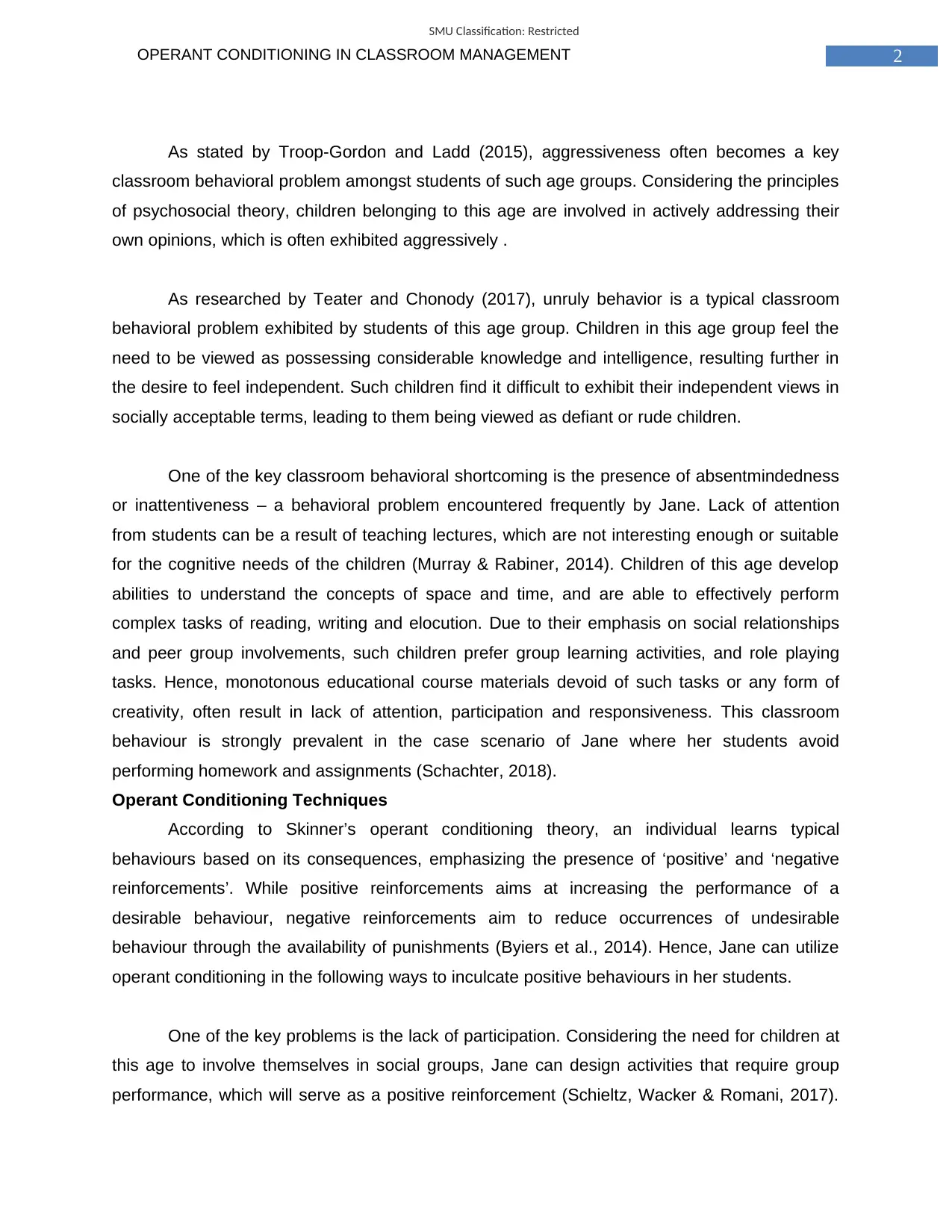
2OPERANT CONDITIONING IN CLASSROOM MANAGEMENT
SMU Classification: Restricted
As stated by Troop-Gordon and Ladd (2015), aggressiveness often becomes a key
classroom behavioral problem amongst students of such age groups. Considering the principles
of psychosocial theory, children belonging to this age are involved in actively addressing their
own opinions, which is often exhibited aggressively .
As researched by Teater and Chonody (2017), unruly behavior is a typical classroom
behavioral problem exhibited by students of this age group. Children in this age group feel the
need to be viewed as possessing considerable knowledge and intelligence, resulting further in
the desire to feel independent. Such children find it difficult to exhibit their independent views in
socially acceptable terms, leading to them being viewed as defiant or rude children.
One of the key classroom behavioral shortcoming is the presence of absentmindedness
or inattentiveness – a behavioral problem encountered frequently by Jane. Lack of attention
from students can be a result of teaching lectures, which are not interesting enough or suitable
for the cognitive needs of the children (Murray & Rabiner, 2014). Children of this age develop
abilities to understand the concepts of space and time, and are able to effectively perform
complex tasks of reading, writing and elocution. Due to their emphasis on social relationships
and peer group involvements, such children prefer group learning activities, and role playing
tasks. Hence, monotonous educational course materials devoid of such tasks or any form of
creativity, often result in lack of attention, participation and responsiveness. This classroom
behaviour is strongly prevalent in the case scenario of Jane where her students avoid
performing homework and assignments (Schachter, 2018).
Operant Conditioning Techniques
According to Skinner’s operant conditioning theory, an individual learns typical
behaviours based on its consequences, emphasizing the presence of ‘positive’ and ‘negative
reinforcements’. While positive reinforcements aims at increasing the performance of a
desirable behaviour, negative reinforcements aim to reduce occurrences of undesirable
behaviour through the availability of punishments (Byiers et al., 2014). Hence, Jane can utilize
operant conditioning in the following ways to inculcate positive behaviours in her students.
One of the key problems is the lack of participation. Considering the need for children at
this age to involve themselves in social groups, Jane can design activities that require group
performance, which will serve as a positive reinforcement (Schieltz, Wacker & Romani, 2017).
SMU Classification: Restricted
As stated by Troop-Gordon and Ladd (2015), aggressiveness often becomes a key
classroom behavioral problem amongst students of such age groups. Considering the principles
of psychosocial theory, children belonging to this age are involved in actively addressing their
own opinions, which is often exhibited aggressively .
As researched by Teater and Chonody (2017), unruly behavior is a typical classroom
behavioral problem exhibited by students of this age group. Children in this age group feel the
need to be viewed as possessing considerable knowledge and intelligence, resulting further in
the desire to feel independent. Such children find it difficult to exhibit their independent views in
socially acceptable terms, leading to them being viewed as defiant or rude children.
One of the key classroom behavioral shortcoming is the presence of absentmindedness
or inattentiveness – a behavioral problem encountered frequently by Jane. Lack of attention
from students can be a result of teaching lectures, which are not interesting enough or suitable
for the cognitive needs of the children (Murray & Rabiner, 2014). Children of this age develop
abilities to understand the concepts of space and time, and are able to effectively perform
complex tasks of reading, writing and elocution. Due to their emphasis on social relationships
and peer group involvements, such children prefer group learning activities, and role playing
tasks. Hence, monotonous educational course materials devoid of such tasks or any form of
creativity, often result in lack of attention, participation and responsiveness. This classroom
behaviour is strongly prevalent in the case scenario of Jane where her students avoid
performing homework and assignments (Schachter, 2018).
Operant Conditioning Techniques
According to Skinner’s operant conditioning theory, an individual learns typical
behaviours based on its consequences, emphasizing the presence of ‘positive’ and ‘negative
reinforcements’. While positive reinforcements aims at increasing the performance of a
desirable behaviour, negative reinforcements aim to reduce occurrences of undesirable
behaviour through the availability of punishments (Byiers et al., 2014). Hence, Jane can utilize
operant conditioning in the following ways to inculcate positive behaviours in her students.
One of the key problems is the lack of participation. Considering the need for children at
this age to involve themselves in social groups, Jane can design activities that require group
performance, which will serve as a positive reinforcement (Schieltz, Wacker & Romani, 2017).
⊘ This is a preview!⊘
Do you want full access?
Subscribe today to unlock all pages.

Trusted by 1+ million students worldwide
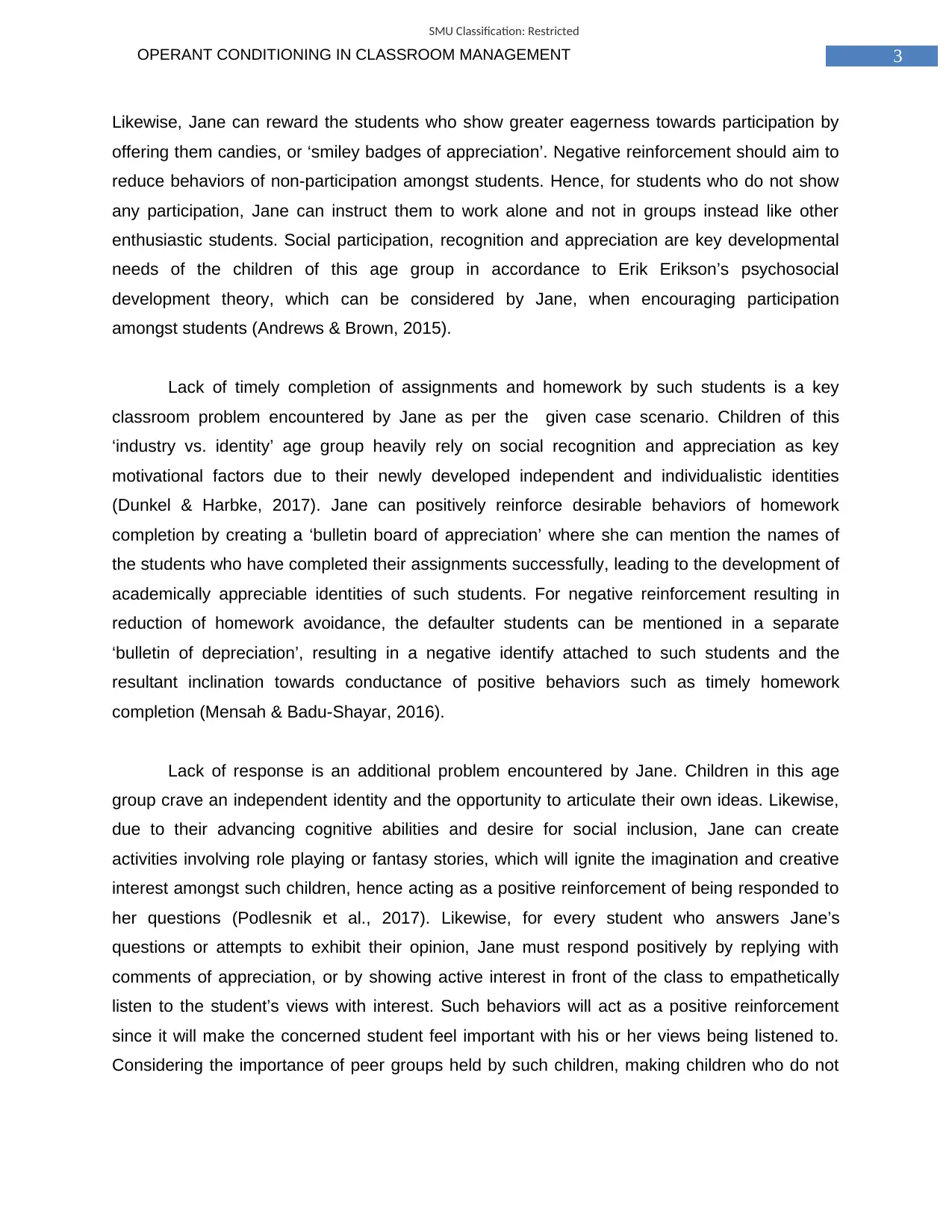
3OPERANT CONDITIONING IN CLASSROOM MANAGEMENT
SMU Classification: Restricted
Likewise, Jane can reward the students who show greater eagerness towards participation by
offering them candies, or ‘smiley badges of appreciation’. Negative reinforcement should aim to
reduce behaviors of non-participation amongst students. Hence, for students who do not show
any participation, Jane can instruct them to work alone and not in groups instead like other
enthusiastic students. Social participation, recognition and appreciation are key developmental
needs of the children of this age group in accordance to Erik Erikson’s psychosocial
development theory, which can be considered by Jane, when encouraging participation
amongst students (Andrews & Brown, 2015).
Lack of timely completion of assignments and homework by such students is a key
classroom problem encountered by Jane as per the given case scenario. Children of this
‘industry vs. identity’ age group heavily rely on social recognition and appreciation as key
motivational factors due to their newly developed independent and individualistic identities
(Dunkel & Harbke, 2017). Jane can positively reinforce desirable behaviors of homework
completion by creating a ‘bulletin board of appreciation’ where she can mention the names of
the students who have completed their assignments successfully, leading to the development of
academically appreciable identities of such students. For negative reinforcement resulting in
reduction of homework avoidance, the defaulter students can be mentioned in a separate
‘bulletin of depreciation’, resulting in a negative identify attached to such students and the
resultant inclination towards conductance of positive behaviors such as timely homework
completion (Mensah & Badu-Shayar, 2016).
Lack of response is an additional problem encountered by Jane. Children in this age
group crave an independent identity and the opportunity to articulate their own ideas. Likewise,
due to their advancing cognitive abilities and desire for social inclusion, Jane can create
activities involving role playing or fantasy stories, which will ignite the imagination and creative
interest amongst such children, hence acting as a positive reinforcement of being responded to
her questions (Podlesnik et al., 2017). Likewise, for every student who answers Jane’s
questions or attempts to exhibit their opinion, Jane must respond positively by replying with
comments of appreciation, or by showing active interest in front of the class to empathetically
listen to the student’s views with interest. Such behaviors will act as a positive reinforcement
since it will make the concerned student feel important with his or her views being listened to.
Considering the importance of peer groups held by such children, making children who do not
SMU Classification: Restricted
Likewise, Jane can reward the students who show greater eagerness towards participation by
offering them candies, or ‘smiley badges of appreciation’. Negative reinforcement should aim to
reduce behaviors of non-participation amongst students. Hence, for students who do not show
any participation, Jane can instruct them to work alone and not in groups instead like other
enthusiastic students. Social participation, recognition and appreciation are key developmental
needs of the children of this age group in accordance to Erik Erikson’s psychosocial
development theory, which can be considered by Jane, when encouraging participation
amongst students (Andrews & Brown, 2015).
Lack of timely completion of assignments and homework by such students is a key
classroom problem encountered by Jane as per the given case scenario. Children of this
‘industry vs. identity’ age group heavily rely on social recognition and appreciation as key
motivational factors due to their newly developed independent and individualistic identities
(Dunkel & Harbke, 2017). Jane can positively reinforce desirable behaviors of homework
completion by creating a ‘bulletin board of appreciation’ where she can mention the names of
the students who have completed their assignments successfully, leading to the development of
academically appreciable identities of such students. For negative reinforcement resulting in
reduction of homework avoidance, the defaulter students can be mentioned in a separate
‘bulletin of depreciation’, resulting in a negative identify attached to such students and the
resultant inclination towards conductance of positive behaviors such as timely homework
completion (Mensah & Badu-Shayar, 2016).
Lack of response is an additional problem encountered by Jane. Children in this age
group crave an independent identity and the opportunity to articulate their own ideas. Likewise,
due to their advancing cognitive abilities and desire for social inclusion, Jane can create
activities involving role playing or fantasy stories, which will ignite the imagination and creative
interest amongst such children, hence acting as a positive reinforcement of being responded to
her questions (Podlesnik et al., 2017). Likewise, for every student who answers Jane’s
questions or attempts to exhibit their opinion, Jane must respond positively by replying with
comments of appreciation, or by showing active interest in front of the class to empathetically
listen to the student’s views with interest. Such behaviors will act as a positive reinforcement
since it will make the concerned student feel important with his or her views being listened to.
Considering the importance of peer groups held by such children, making children who do not
Paraphrase This Document
Need a fresh take? Get an instant paraphrase of this document with our AI Paraphraser
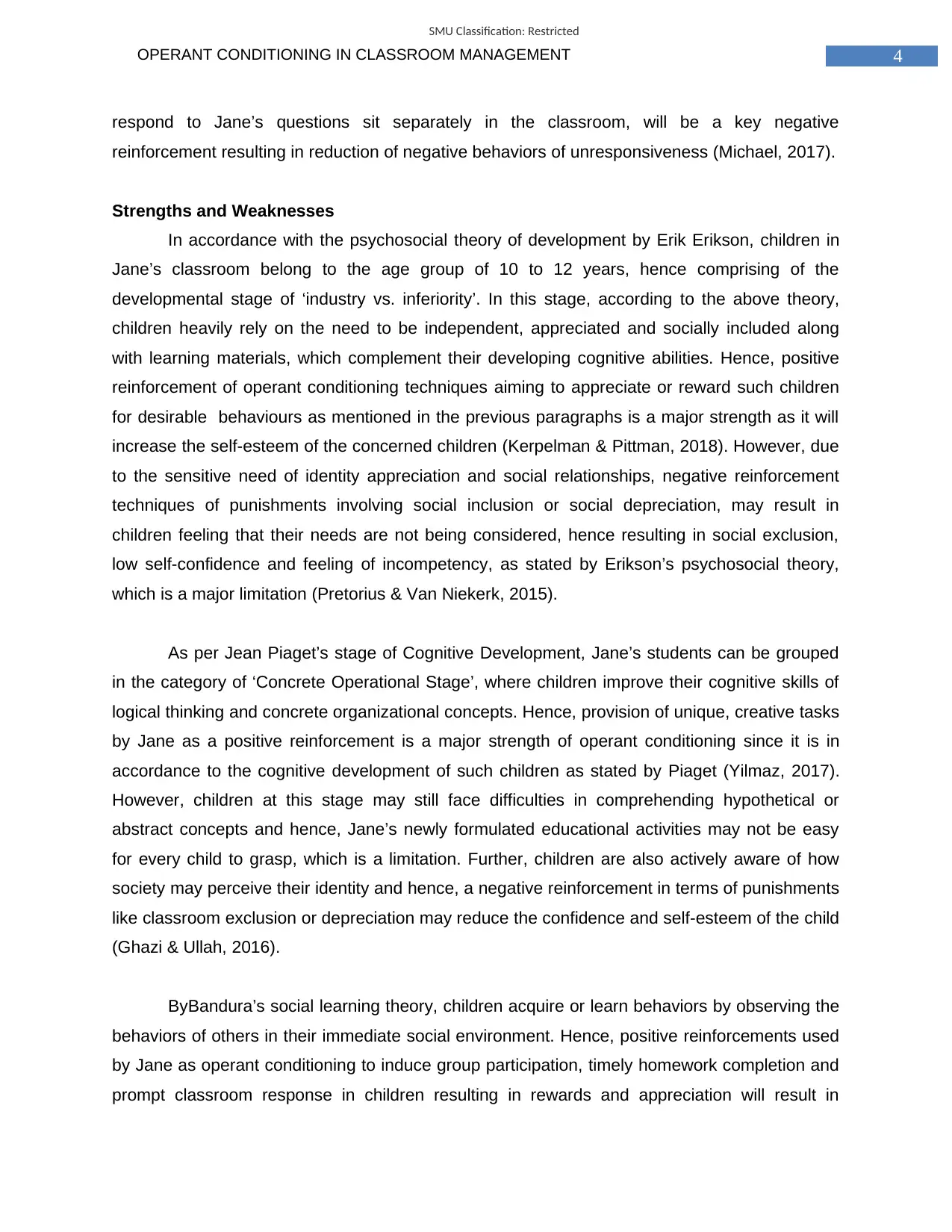
4OPERANT CONDITIONING IN CLASSROOM MANAGEMENT
SMU Classification: Restricted
respond to Jane’s questions sit separately in the classroom, will be a key negative
reinforcement resulting in reduction of negative behaviors of unresponsiveness (Michael, 2017).
Strengths and Weaknesses
In accordance with the psychosocial theory of development by Erik Erikson, children in
Jane’s classroom belong to the age group of 10 to 12 years, hence comprising of the
developmental stage of ‘industry vs. inferiority’. In this stage, according to the above theory,
children heavily rely on the need to be independent, appreciated and socially included along
with learning materials, which complement their developing cognitive abilities. Hence, positive
reinforcement of operant conditioning techniques aiming to appreciate or reward such children
for desirable behaviours as mentioned in the previous paragraphs is a major strength as it will
increase the self-esteem of the concerned children (Kerpelman & Pittman, 2018). However, due
to the sensitive need of identity appreciation and social relationships, negative reinforcement
techniques of punishments involving social inclusion or social depreciation, may result in
children feeling that their needs are not being considered, hence resulting in social exclusion,
low self-confidence and feeling of incompetency, as stated by Erikson’s psychosocial theory,
which is a major limitation (Pretorius & Van Niekerk, 2015).
As per Jean Piaget’s stage of Cognitive Development, Jane’s students can be grouped
in the category of ‘Concrete Operational Stage’, where children improve their cognitive skills of
logical thinking and concrete organizational concepts. Hence, provision of unique, creative tasks
by Jane as a positive reinforcement is a major strength of operant conditioning since it is in
accordance to the cognitive development of such children as stated by Piaget (Yilmaz, 2017).
However, children at this stage may still face difficulties in comprehending hypothetical or
abstract concepts and hence, Jane’s newly formulated educational activities may not be easy
for every child to grasp, which is a limitation. Further, children are also actively aware of how
society may perceive their identity and hence, a negative reinforcement in terms of punishments
like classroom exclusion or depreciation may reduce the confidence and self-esteem of the child
(Ghazi & Ullah, 2016).
ByBandura’s social learning theory, children acquire or learn behaviors by observing the
behaviors of others in their immediate social environment. Hence, positive reinforcements used
by Jane as operant conditioning to induce group participation, timely homework completion and
prompt classroom response in children resulting in rewards and appreciation will result in
SMU Classification: Restricted
respond to Jane’s questions sit separately in the classroom, will be a key negative
reinforcement resulting in reduction of negative behaviors of unresponsiveness (Michael, 2017).
Strengths and Weaknesses
In accordance with the psychosocial theory of development by Erik Erikson, children in
Jane’s classroom belong to the age group of 10 to 12 years, hence comprising of the
developmental stage of ‘industry vs. inferiority’. In this stage, according to the above theory,
children heavily rely on the need to be independent, appreciated and socially included along
with learning materials, which complement their developing cognitive abilities. Hence, positive
reinforcement of operant conditioning techniques aiming to appreciate or reward such children
for desirable behaviours as mentioned in the previous paragraphs is a major strength as it will
increase the self-esteem of the concerned children (Kerpelman & Pittman, 2018). However, due
to the sensitive need of identity appreciation and social relationships, negative reinforcement
techniques of punishments involving social inclusion or social depreciation, may result in
children feeling that their needs are not being considered, hence resulting in social exclusion,
low self-confidence and feeling of incompetency, as stated by Erikson’s psychosocial theory,
which is a major limitation (Pretorius & Van Niekerk, 2015).
As per Jean Piaget’s stage of Cognitive Development, Jane’s students can be grouped
in the category of ‘Concrete Operational Stage’, where children improve their cognitive skills of
logical thinking and concrete organizational concepts. Hence, provision of unique, creative tasks
by Jane as a positive reinforcement is a major strength of operant conditioning since it is in
accordance to the cognitive development of such children as stated by Piaget (Yilmaz, 2017).
However, children at this stage may still face difficulties in comprehending hypothetical or
abstract concepts and hence, Jane’s newly formulated educational activities may not be easy
for every child to grasp, which is a limitation. Further, children are also actively aware of how
society may perceive their identity and hence, a negative reinforcement in terms of punishments
like classroom exclusion or depreciation may reduce the confidence and self-esteem of the child
(Ghazi & Ullah, 2016).
ByBandura’s social learning theory, children acquire or learn behaviors by observing the
behaviors of others in their immediate social environment. Hence, positive reinforcements used
by Jane as operant conditioning to induce group participation, timely homework completion and
prompt classroom response in children resulting in rewards and appreciation will result in
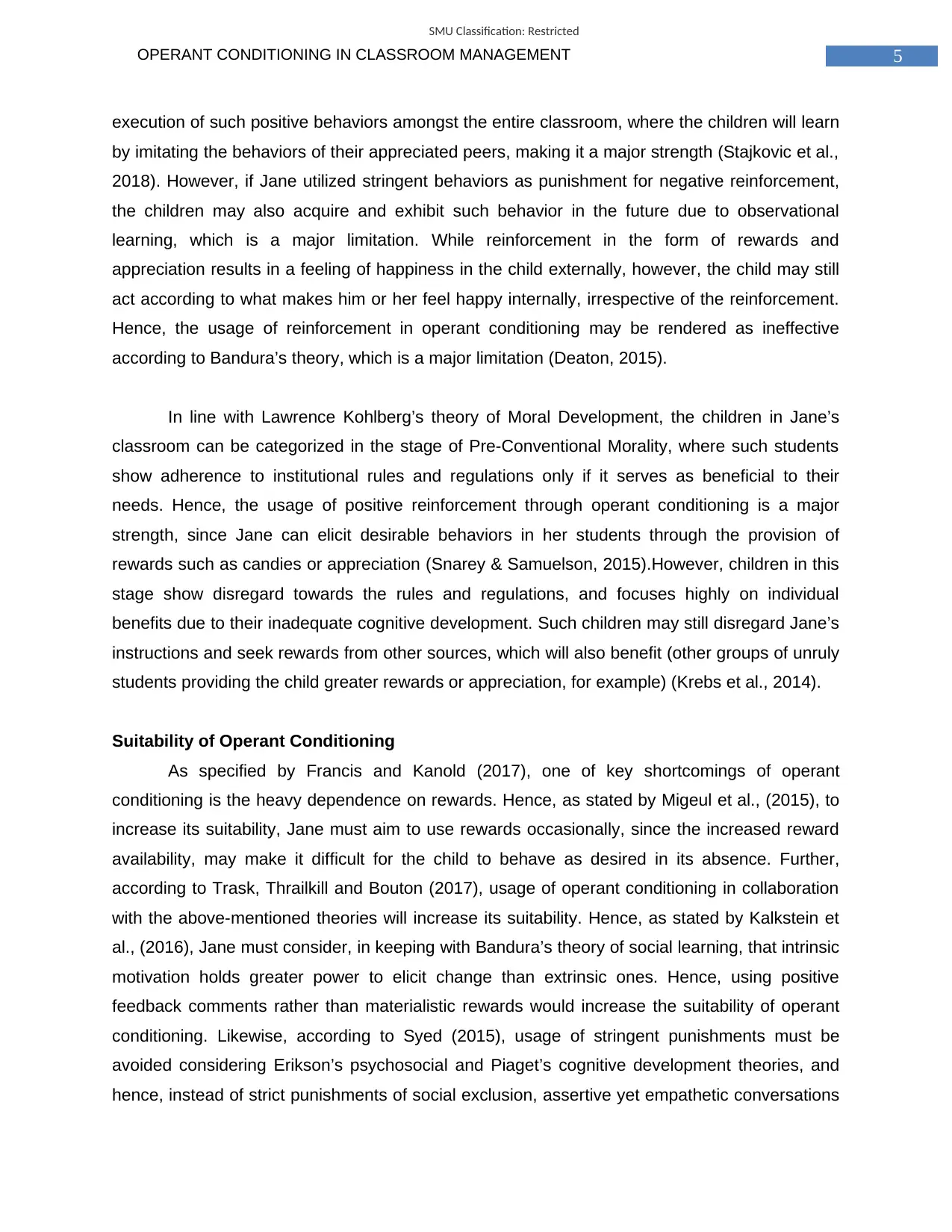
5OPERANT CONDITIONING IN CLASSROOM MANAGEMENT
SMU Classification: Restricted
execution of such positive behaviors amongst the entire classroom, where the children will learn
by imitating the behaviors of their appreciated peers, making it a major strength (Stajkovic et al.,
2018). However, if Jane utilized stringent behaviors as punishment for negative reinforcement,
the children may also acquire and exhibit such behavior in the future due to observational
learning, which is a major limitation. While reinforcement in the form of rewards and
appreciation results in a feeling of happiness in the child externally, however, the child may still
act according to what makes him or her feel happy internally, irrespective of the reinforcement.
Hence, the usage of reinforcement in operant conditioning may be rendered as ineffective
according to Bandura’s theory, which is a major limitation (Deaton, 2015).
In line with Lawrence Kohlberg’s theory of Moral Development, the children in Jane’s
classroom can be categorized in the stage of Pre-Conventional Morality, where such students
show adherence to institutional rules and regulations only if it serves as beneficial to their
needs. Hence, the usage of positive reinforcement through operant conditioning is a major
strength, since Jane can elicit desirable behaviors in her students through the provision of
rewards such as candies or appreciation (Snarey & Samuelson, 2015).However, children in this
stage show disregard towards the rules and regulations, and focuses highly on individual
benefits due to their inadequate cognitive development. Such children may still disregard Jane’s
instructions and seek rewards from other sources, which will also benefit (other groups of unruly
students providing the child greater rewards or appreciation, for example) (Krebs et al., 2014).
Suitability of Operant Conditioning
As specified by Francis and Kanold (2017), one of key shortcomings of operant
conditioning is the heavy dependence on rewards. Hence, as stated by Migeul et al., (2015), to
increase its suitability, Jane must aim to use rewards occasionally, since the increased reward
availability, may make it difficult for the child to behave as desired in its absence. Further,
according to Trask, Thrailkill and Bouton (2017), usage of operant conditioning in collaboration
with the above-mentioned theories will increase its suitability. Hence, as stated by Kalkstein et
al., (2016), Jane must consider, in keeping with Bandura’s theory of social learning, that intrinsic
motivation holds greater power to elicit change than extrinsic ones. Hence, using positive
feedback comments rather than materialistic rewards would increase the suitability of operant
conditioning. Likewise, according to Syed (2015), usage of stringent punishments must be
avoided considering Erikson’s psychosocial and Piaget’s cognitive development theories, and
hence, instead of strict punishments of social exclusion, assertive yet empathetic conversations
SMU Classification: Restricted
execution of such positive behaviors amongst the entire classroom, where the children will learn
by imitating the behaviors of their appreciated peers, making it a major strength (Stajkovic et al.,
2018). However, if Jane utilized stringent behaviors as punishment for negative reinforcement,
the children may also acquire and exhibit such behavior in the future due to observational
learning, which is a major limitation. While reinforcement in the form of rewards and
appreciation results in a feeling of happiness in the child externally, however, the child may still
act according to what makes him or her feel happy internally, irrespective of the reinforcement.
Hence, the usage of reinforcement in operant conditioning may be rendered as ineffective
according to Bandura’s theory, which is a major limitation (Deaton, 2015).
In line with Lawrence Kohlberg’s theory of Moral Development, the children in Jane’s
classroom can be categorized in the stage of Pre-Conventional Morality, where such students
show adherence to institutional rules and regulations only if it serves as beneficial to their
needs. Hence, the usage of positive reinforcement through operant conditioning is a major
strength, since Jane can elicit desirable behaviors in her students through the provision of
rewards such as candies or appreciation (Snarey & Samuelson, 2015).However, children in this
stage show disregard towards the rules and regulations, and focuses highly on individual
benefits due to their inadequate cognitive development. Such children may still disregard Jane’s
instructions and seek rewards from other sources, which will also benefit (other groups of unruly
students providing the child greater rewards or appreciation, for example) (Krebs et al., 2014).
Suitability of Operant Conditioning
As specified by Francis and Kanold (2017), one of key shortcomings of operant
conditioning is the heavy dependence on rewards. Hence, as stated by Migeul et al., (2015), to
increase its suitability, Jane must aim to use rewards occasionally, since the increased reward
availability, may make it difficult for the child to behave as desired in its absence. Further,
according to Trask, Thrailkill and Bouton (2017), usage of operant conditioning in collaboration
with the above-mentioned theories will increase its suitability. Hence, as stated by Kalkstein et
al., (2016), Jane must consider, in keeping with Bandura’s theory of social learning, that intrinsic
motivation holds greater power to elicit change than extrinsic ones. Hence, using positive
feedback comments rather than materialistic rewards would increase the suitability of operant
conditioning. Likewise, according to Syed (2015), usage of stringent punishments must be
avoided considering Erikson’s psychosocial and Piaget’s cognitive development theories, and
hence, instead of strict punishments of social exclusion, assertive yet empathetic conversations
⊘ This is a preview!⊘
Do you want full access?
Subscribe today to unlock all pages.

Trusted by 1+ million students worldwide
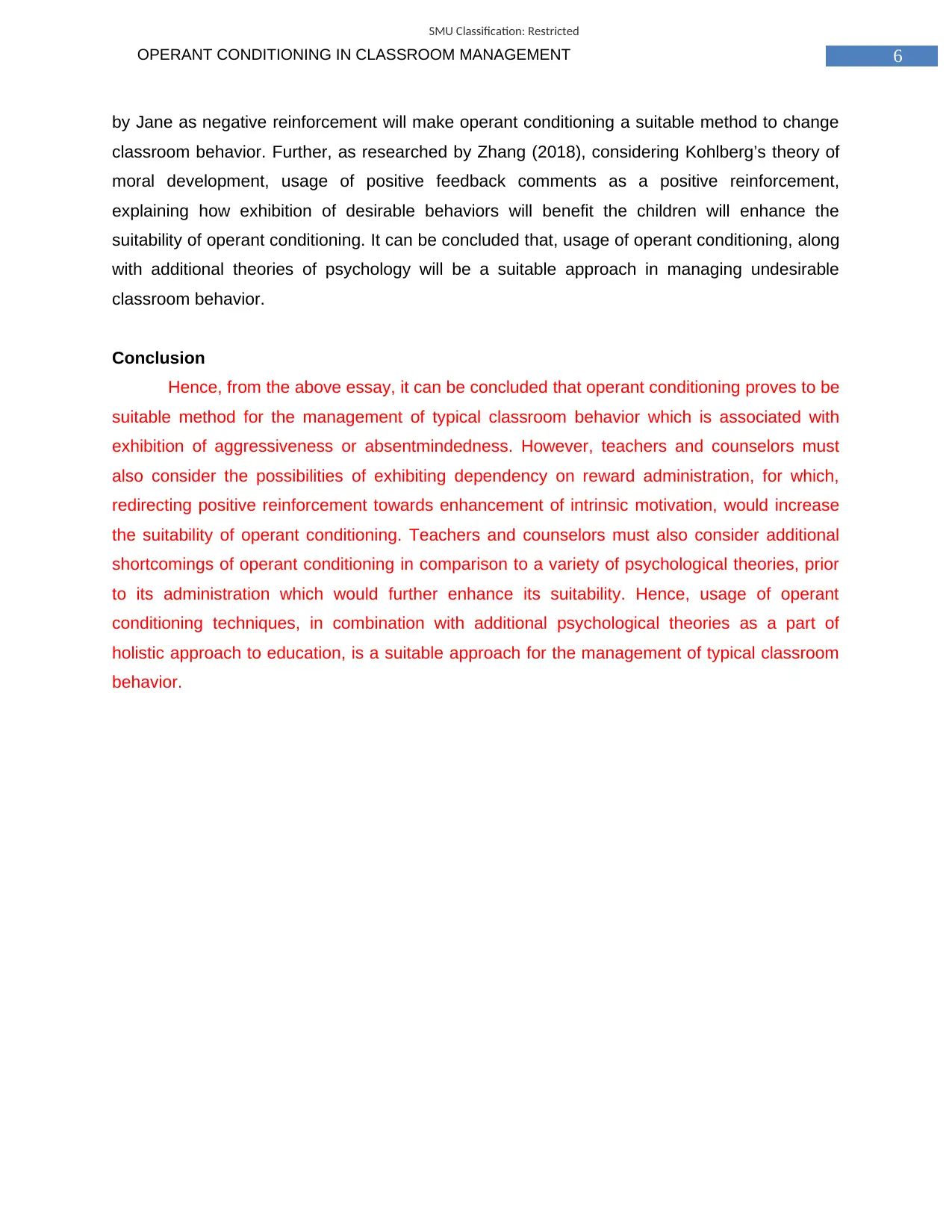
6OPERANT CONDITIONING IN CLASSROOM MANAGEMENT
SMU Classification: Restricted
by Jane as negative reinforcement will make operant conditioning a suitable method to change
classroom behavior. Further, as researched by Zhang (2018), considering Kohlberg’s theory of
moral development, usage of positive feedback comments as a positive reinforcement,
explaining how exhibition of desirable behaviors will benefit the children will enhance the
suitability of operant conditioning. It can be concluded that, usage of operant conditioning, along
with additional theories of psychology will be a suitable approach in managing undesirable
classroom behavior.
Conclusion
Hence, from the above essay, it can be concluded that operant conditioning proves to be
suitable method for the management of typical classroom behavior which is associated with
exhibition of aggressiveness or absentmindedness. However, teachers and counselors must
also consider the possibilities of exhibiting dependency on reward administration, for which,
redirecting positive reinforcement towards enhancement of intrinsic motivation, would increase
the suitability of operant conditioning. Teachers and counselors must also consider additional
shortcomings of operant conditioning in comparison to a variety of psychological theories, prior
to its administration which would further enhance its suitability. Hence, usage of operant
conditioning techniques, in combination with additional psychological theories as a part of
holistic approach to education, is a suitable approach for the management of typical classroom
behavior.
SMU Classification: Restricted
by Jane as negative reinforcement will make operant conditioning a suitable method to change
classroom behavior. Further, as researched by Zhang (2018), considering Kohlberg’s theory of
moral development, usage of positive feedback comments as a positive reinforcement,
explaining how exhibition of desirable behaviors will benefit the children will enhance the
suitability of operant conditioning. It can be concluded that, usage of operant conditioning, along
with additional theories of psychology will be a suitable approach in managing undesirable
classroom behavior.
Conclusion
Hence, from the above essay, it can be concluded that operant conditioning proves to be
suitable method for the management of typical classroom behavior which is associated with
exhibition of aggressiveness or absentmindedness. However, teachers and counselors must
also consider the possibilities of exhibiting dependency on reward administration, for which,
redirecting positive reinforcement towards enhancement of intrinsic motivation, would increase
the suitability of operant conditioning. Teachers and counselors must also consider additional
shortcomings of operant conditioning in comparison to a variety of psychological theories, prior
to its administration which would further enhance its suitability. Hence, usage of operant
conditioning techniques, in combination with additional psychological theories as a part of
holistic approach to education, is a suitable approach for the management of typical classroom
behavior.
Paraphrase This Document
Need a fresh take? Get an instant paraphrase of this document with our AI Paraphraser
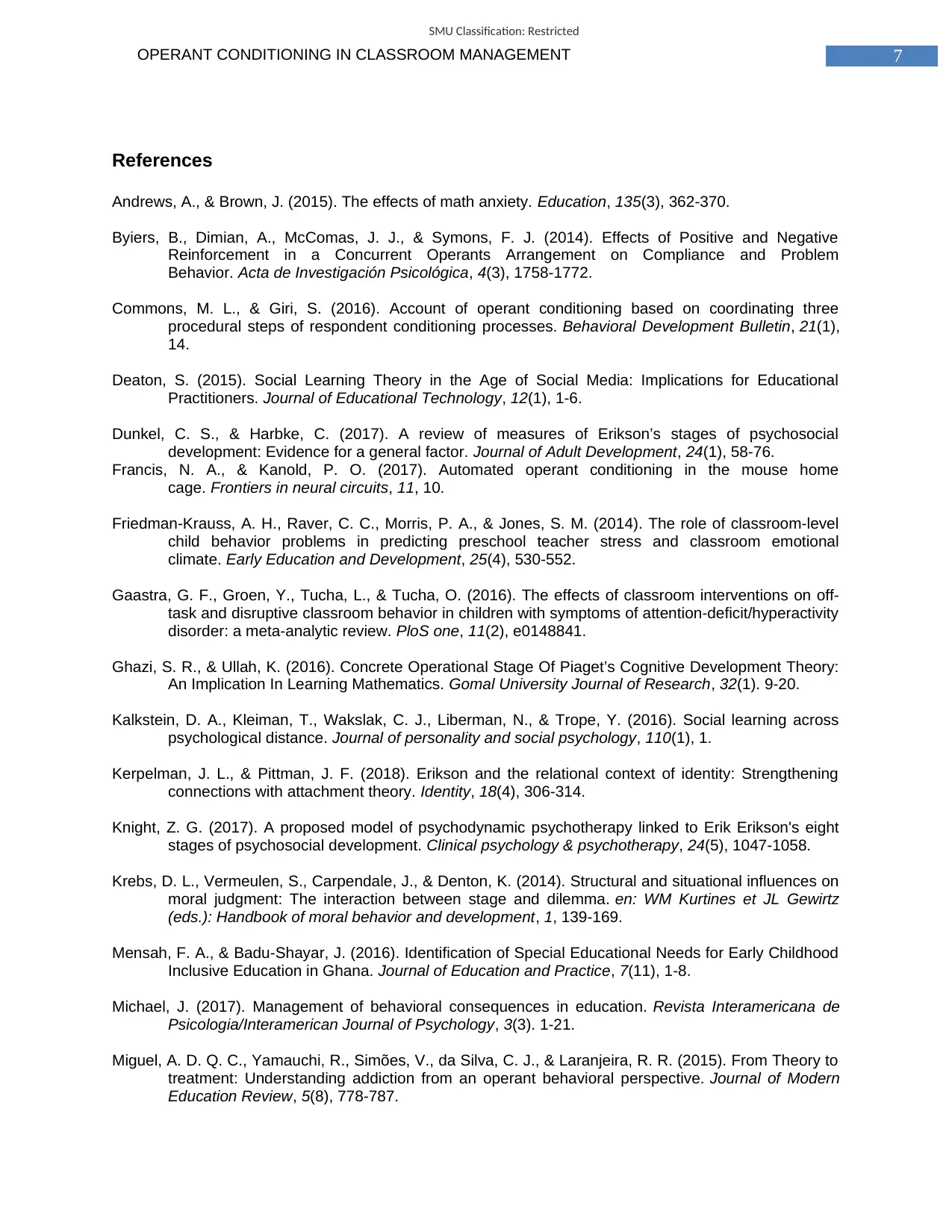
7OPERANT CONDITIONING IN CLASSROOM MANAGEMENT
SMU Classification: Restricted
References
Andrews, A., & Brown, J. (2015). The effects of math anxiety. Education, 135(3), 362-370.
Byiers, B., Dimian, A., McComas, J. J., & Symons, F. J. (2014). Effects of Positive and Negative
Reinforcement in a Concurrent Operants Arrangement on Compliance and Problem
Behavior. Acta de Investigación Psicológica, 4(3), 1758-1772.
Commons, M. L., & Giri, S. (2016). Account of operant conditioning based on coordinating three
procedural steps of respondent conditioning processes. Behavioral Development Bulletin, 21(1),
14.
Deaton, S. (2015). Social Learning Theory in the Age of Social Media: Implications for Educational
Practitioners. Journal of Educational Technology, 12(1), 1-6.
Dunkel, C. S., & Harbke, C. (2017). A review of measures of Erikson’s stages of psychosocial
development: Evidence for a general factor. Journal of Adult Development, 24(1), 58-76.
Francis, N. A., & Kanold, P. O. (2017). Automated operant conditioning in the mouse home
cage. Frontiers in neural circuits, 11, 10.
Friedman-Krauss, A. H., Raver, C. C., Morris, P. A., & Jones, S. M. (2014). The role of classroom-level
child behavior problems in predicting preschool teacher stress and classroom emotional
climate. Early Education and Development, 25(4), 530-552.
Gaastra, G. F., Groen, Y., Tucha, L., & Tucha, O. (2016). The effects of classroom interventions on off-
task and disruptive classroom behavior in children with symptoms of attention-deficit/hyperactivity
disorder: a meta-analytic review. PloS one, 11(2), e0148841.
Ghazi, S. R., & Ullah, K. (2016). Concrete Operational Stage Of Piaget’s Cognitive Development Theory:
An Implication In Learning Mathematics. Gomal University Journal of Research, 32(1). 9-20.
Kalkstein, D. A., Kleiman, T., Wakslak, C. J., Liberman, N., & Trope, Y. (2016). Social learning across
psychological distance. Journal of personality and social psychology, 110(1), 1.
Kerpelman, J. L., & Pittman, J. F. (2018). Erikson and the relational context of identity: Strengthening
connections with attachment theory. Identity, 18(4), 306-314.
Knight, Z. G. (2017). A proposed model of psychodynamic psychotherapy linked to Erik Erikson's eight
stages of psychosocial development. Clinical psychology & psychotherapy, 24(5), 1047-1058.
Krebs, D. L., Vermeulen, S., Carpendale, J., & Denton, K. (2014). Structural and situational influences on
moral judgment: The interaction between stage and dilemma. en: WM Kurtines et JL Gewirtz
(eds.): Handbook of moral behavior and development, 1, 139-169.
Mensah, F. A., & Badu-Shayar, J. (2016). Identification of Special Educational Needs for Early Childhood
Inclusive Education in Ghana. Journal of Education and Practice, 7(11), 1-8.
Michael, J. (2017). Management of behavioral consequences in education. Revista Interamericana de
Psicologia/Interamerican Journal of Psychology, 3(3). 1-21.
Miguel, A. D. Q. C., Yamauchi, R., Simões, V., da Silva, C. J., & Laranjeira, R. R. (2015). From Theory to
treatment: Understanding addiction from an operant behavioral perspective. Journal of Modern
Education Review, 5(8), 778-787.
SMU Classification: Restricted
References
Andrews, A., & Brown, J. (2015). The effects of math anxiety. Education, 135(3), 362-370.
Byiers, B., Dimian, A., McComas, J. J., & Symons, F. J. (2014). Effects of Positive and Negative
Reinforcement in a Concurrent Operants Arrangement on Compliance and Problem
Behavior. Acta de Investigación Psicológica, 4(3), 1758-1772.
Commons, M. L., & Giri, S. (2016). Account of operant conditioning based on coordinating three
procedural steps of respondent conditioning processes. Behavioral Development Bulletin, 21(1),
14.
Deaton, S. (2015). Social Learning Theory in the Age of Social Media: Implications for Educational
Practitioners. Journal of Educational Technology, 12(1), 1-6.
Dunkel, C. S., & Harbke, C. (2017). A review of measures of Erikson’s stages of psychosocial
development: Evidence for a general factor. Journal of Adult Development, 24(1), 58-76.
Francis, N. A., & Kanold, P. O. (2017). Automated operant conditioning in the mouse home
cage. Frontiers in neural circuits, 11, 10.
Friedman-Krauss, A. H., Raver, C. C., Morris, P. A., & Jones, S. M. (2014). The role of classroom-level
child behavior problems in predicting preschool teacher stress and classroom emotional
climate. Early Education and Development, 25(4), 530-552.
Gaastra, G. F., Groen, Y., Tucha, L., & Tucha, O. (2016). The effects of classroom interventions on off-
task and disruptive classroom behavior in children with symptoms of attention-deficit/hyperactivity
disorder: a meta-analytic review. PloS one, 11(2), e0148841.
Ghazi, S. R., & Ullah, K. (2016). Concrete Operational Stage Of Piaget’s Cognitive Development Theory:
An Implication In Learning Mathematics. Gomal University Journal of Research, 32(1). 9-20.
Kalkstein, D. A., Kleiman, T., Wakslak, C. J., Liberman, N., & Trope, Y. (2016). Social learning across
psychological distance. Journal of personality and social psychology, 110(1), 1.
Kerpelman, J. L., & Pittman, J. F. (2018). Erikson and the relational context of identity: Strengthening
connections with attachment theory. Identity, 18(4), 306-314.
Knight, Z. G. (2017). A proposed model of psychodynamic psychotherapy linked to Erik Erikson's eight
stages of psychosocial development. Clinical psychology & psychotherapy, 24(5), 1047-1058.
Krebs, D. L., Vermeulen, S., Carpendale, J., & Denton, K. (2014). Structural and situational influences on
moral judgment: The interaction between stage and dilemma. en: WM Kurtines et JL Gewirtz
(eds.): Handbook of moral behavior and development, 1, 139-169.
Mensah, F. A., & Badu-Shayar, J. (2016). Identification of Special Educational Needs for Early Childhood
Inclusive Education in Ghana. Journal of Education and Practice, 7(11), 1-8.
Michael, J. (2017). Management of behavioral consequences in education. Revista Interamericana de
Psicologia/Interamerican Journal of Psychology, 3(3). 1-21.
Miguel, A. D. Q. C., Yamauchi, R., Simões, V., da Silva, C. J., & Laranjeira, R. R. (2015). From Theory to
treatment: Understanding addiction from an operant behavioral perspective. Journal of Modern
Education Review, 5(8), 778-787.
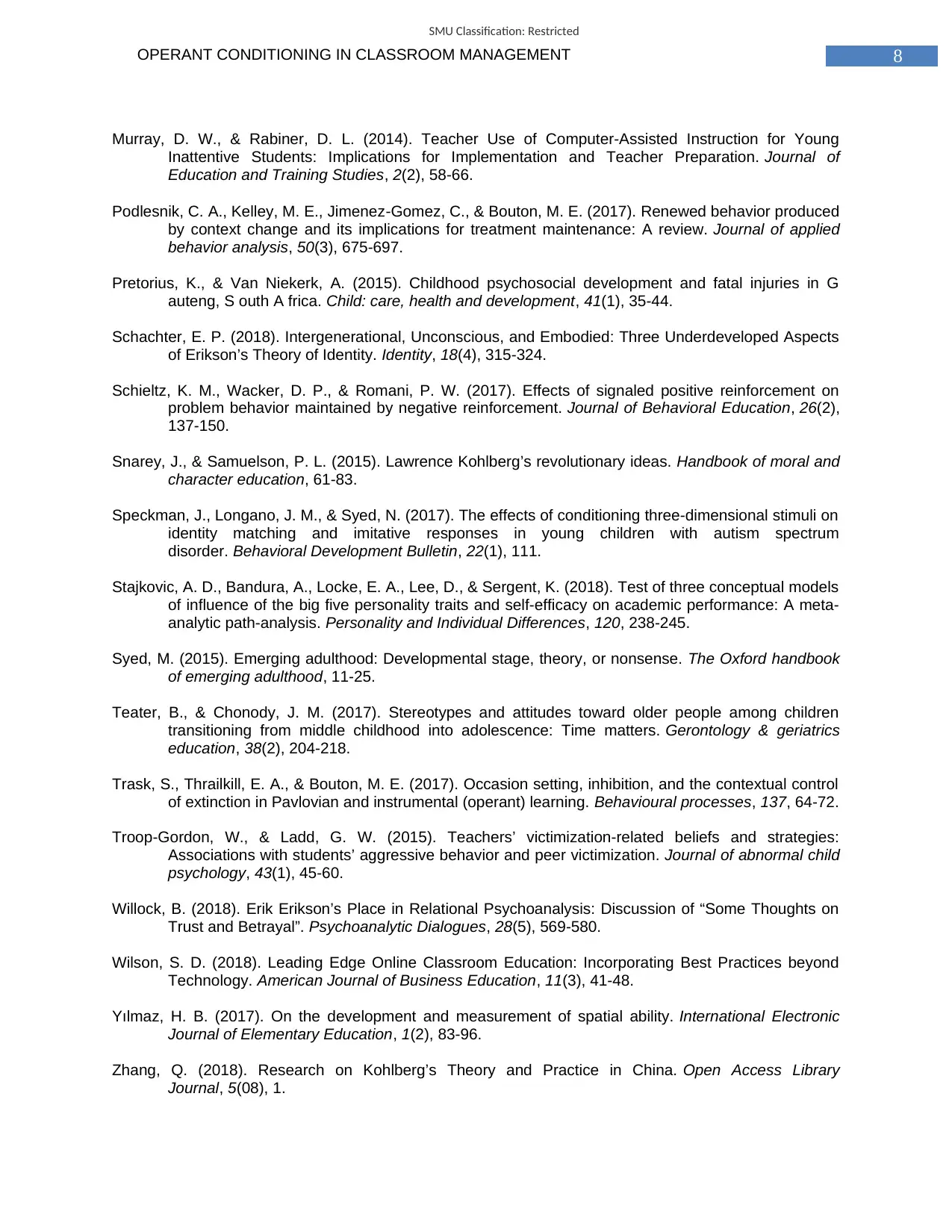
8OPERANT CONDITIONING IN CLASSROOM MANAGEMENT
SMU Classification: Restricted
Murray, D. W., & Rabiner, D. L. (2014). Teacher Use of Computer-Assisted Instruction for Young
Inattentive Students: Implications for Implementation and Teacher Preparation. Journal of
Education and Training Studies, 2(2), 58-66.
Podlesnik, C. A., Kelley, M. E., Jimenez‐Gomez, C., & Bouton, M. E. (2017). Renewed behavior produced
by context change and its implications for treatment maintenance: A review. Journal of applied
behavior analysis, 50(3), 675-697.
Pretorius, K., & Van Niekerk, A. (2015). Childhood psychosocial development and fatal injuries in G
auteng, S outh A frica. Child: care, health and development, 41(1), 35-44.
Schachter, E. P. (2018). Intergenerational, Unconscious, and Embodied: Three Underdeveloped Aspects
of Erikson’s Theory of Identity. Identity, 18(4), 315-324.
Schieltz, K. M., Wacker, D. P., & Romani, P. W. (2017). Effects of signaled positive reinforcement on
problem behavior maintained by negative reinforcement. Journal of Behavioral Education, 26(2),
137-150.
Snarey, J., & Samuelson, P. L. (2015). Lawrence Kohlberg’s revolutionary ideas. Handbook of moral and
character education, 61-83.
Speckman, J., Longano, J. M., & Syed, N. (2017). The effects of conditioning three-dimensional stimuli on
identity matching and imitative responses in young children with autism spectrum
disorder. Behavioral Development Bulletin, 22(1), 111.
Stajkovic, A. D., Bandura, A., Locke, E. A., Lee, D., & Sergent, K. (2018). Test of three conceptual models
of influence of the big five personality traits and self-efficacy on academic performance: A meta-
analytic path-analysis. Personality and Individual Differences, 120, 238-245.
Syed, M. (2015). Emerging adulthood: Developmental stage, theory, or nonsense. The Oxford handbook
of emerging adulthood, 11-25.
Teater, B., & Chonody, J. M. (2017). Stereotypes and attitudes toward older people among children
transitioning from middle childhood into adolescence: Time matters. Gerontology & geriatrics
education, 38(2), 204-218.
Trask, S., Thrailkill, E. A., & Bouton, M. E. (2017). Occasion setting, inhibition, and the contextual control
of extinction in Pavlovian and instrumental (operant) learning. Behavioural processes, 137, 64-72.
Troop-Gordon, W., & Ladd, G. W. (2015). Teachers’ victimization-related beliefs and strategies:
Associations with students’ aggressive behavior and peer victimization. Journal of abnormal child
psychology, 43(1), 45-60.
Willock, B. (2018). Erik Erikson’s Place in Relational Psychoanalysis: Discussion of “Some Thoughts on
Trust and Betrayal”. Psychoanalytic Dialogues, 28(5), 569-580.
Wilson, S. D. (2018). Leading Edge Online Classroom Education: Incorporating Best Practices beyond
Technology. American Journal of Business Education, 11(3), 41-48.
Yılmaz, H. B. (2017). On the development and measurement of spatial ability. International Electronic
Journal of Elementary Education, 1(2), 83-96.
Zhang, Q. (2018). Research on Kohlberg’s Theory and Practice in China. Open Access Library
Journal, 5(08), 1.
SMU Classification: Restricted
Murray, D. W., & Rabiner, D. L. (2014). Teacher Use of Computer-Assisted Instruction for Young
Inattentive Students: Implications for Implementation and Teacher Preparation. Journal of
Education and Training Studies, 2(2), 58-66.
Podlesnik, C. A., Kelley, M. E., Jimenez‐Gomez, C., & Bouton, M. E. (2017). Renewed behavior produced
by context change and its implications for treatment maintenance: A review. Journal of applied
behavior analysis, 50(3), 675-697.
Pretorius, K., & Van Niekerk, A. (2015). Childhood psychosocial development and fatal injuries in G
auteng, S outh A frica. Child: care, health and development, 41(1), 35-44.
Schachter, E. P. (2018). Intergenerational, Unconscious, and Embodied: Three Underdeveloped Aspects
of Erikson’s Theory of Identity. Identity, 18(4), 315-324.
Schieltz, K. M., Wacker, D. P., & Romani, P. W. (2017). Effects of signaled positive reinforcement on
problem behavior maintained by negative reinforcement. Journal of Behavioral Education, 26(2),
137-150.
Snarey, J., & Samuelson, P. L. (2015). Lawrence Kohlberg’s revolutionary ideas. Handbook of moral and
character education, 61-83.
Speckman, J., Longano, J. M., & Syed, N. (2017). The effects of conditioning three-dimensional stimuli on
identity matching and imitative responses in young children with autism spectrum
disorder. Behavioral Development Bulletin, 22(1), 111.
Stajkovic, A. D., Bandura, A., Locke, E. A., Lee, D., & Sergent, K. (2018). Test of three conceptual models
of influence of the big five personality traits and self-efficacy on academic performance: A meta-
analytic path-analysis. Personality and Individual Differences, 120, 238-245.
Syed, M. (2015). Emerging adulthood: Developmental stage, theory, or nonsense. The Oxford handbook
of emerging adulthood, 11-25.
Teater, B., & Chonody, J. M. (2017). Stereotypes and attitudes toward older people among children
transitioning from middle childhood into adolescence: Time matters. Gerontology & geriatrics
education, 38(2), 204-218.
Trask, S., Thrailkill, E. A., & Bouton, M. E. (2017). Occasion setting, inhibition, and the contextual control
of extinction in Pavlovian and instrumental (operant) learning. Behavioural processes, 137, 64-72.
Troop-Gordon, W., & Ladd, G. W. (2015). Teachers’ victimization-related beliefs and strategies:
Associations with students’ aggressive behavior and peer victimization. Journal of abnormal child
psychology, 43(1), 45-60.
Willock, B. (2018). Erik Erikson’s Place in Relational Psychoanalysis: Discussion of “Some Thoughts on
Trust and Betrayal”. Psychoanalytic Dialogues, 28(5), 569-580.
Wilson, S. D. (2018). Leading Edge Online Classroom Education: Incorporating Best Practices beyond
Technology. American Journal of Business Education, 11(3), 41-48.
Yılmaz, H. B. (2017). On the development and measurement of spatial ability. International Electronic
Journal of Elementary Education, 1(2), 83-96.
Zhang, Q. (2018). Research on Kohlberg’s Theory and Practice in China. Open Access Library
Journal, 5(08), 1.
⊘ This is a preview!⊘
Do you want full access?
Subscribe today to unlock all pages.

Trusted by 1+ million students worldwide
1 out of 9
Your All-in-One AI-Powered Toolkit for Academic Success.
+13062052269
info@desklib.com
Available 24*7 on WhatsApp / Email
![[object Object]](/_next/static/media/star-bottom.7253800d.svg)
Unlock your academic potential
Copyright © 2020–2025 A2Z Services. All Rights Reserved. Developed and managed by ZUCOL.